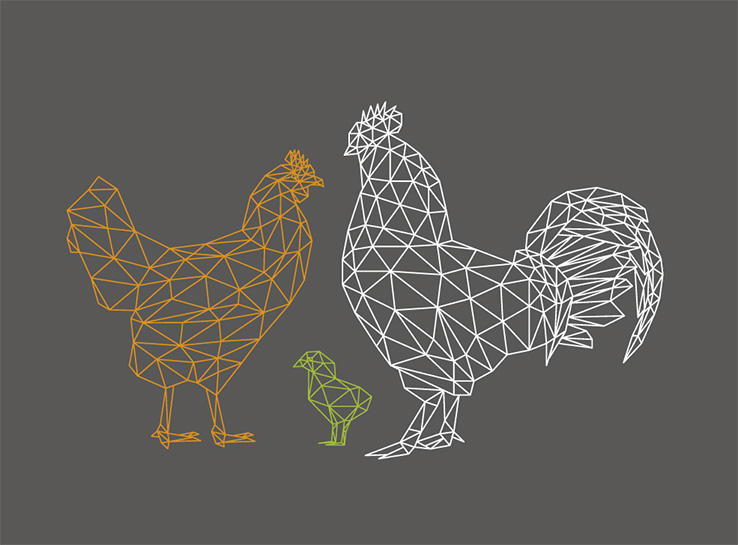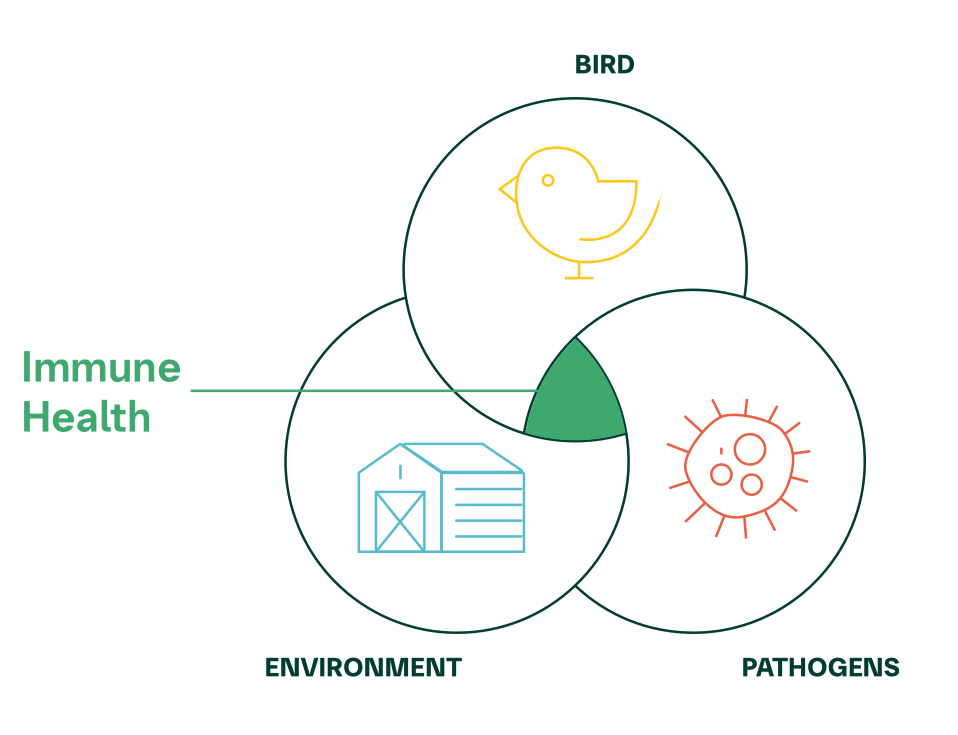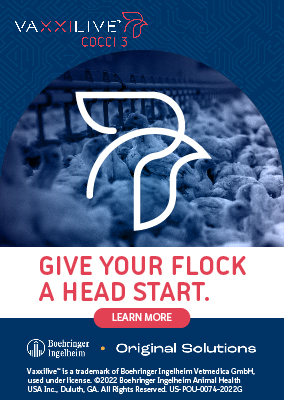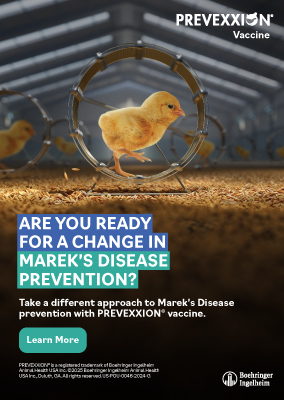 When it comes to ensuring the health and welfare of poultry, most veterinarians are quick to remind producers that “an ounce of prevention is worth a pound of cure.”
When it comes to ensuring the health and welfare of poultry, most veterinarians are quick to remind producers that “an ounce of prevention is worth a pound of cure.”
They’ll also mention that while vaccines are invaluable for protecting flocks against many viral, bacterial and protozoal diseases, they can’t do it all. Many other factors — sanitation, feed, water, ventilation, air quality and biosecurity, to name a few — come into play when fighting primary and secondary infections.
So, what is the best way to safeguard poultry health across a wide range of production systems and management teams?
That’s a question Rick Phillips, DVM, MAM, director of poultry professional services veterinarians at Boehringer Ingelheim, has explored for more than 25 years while working with live-production teams across the US.
He’s concluded that while there have been scores of advances in disease management during that period, implementing and maintaining them has become more challenging due to structural changes in the industry.
More movement, less continuity
“The evolution of our industry tends to be cyclical, and today we have a lot of new people becoming involved,” Phillips says.
“Nowadays, people tend to move more quickly through different career stages, roles and industries. Therefore, there’s a danger of less carryover and continuity for good husbandry and health practices. For example, we’re seeing more instances of disease that are driven by preventable underlying issues.”
This trend has made it more important than ever to call “time out” and revisit the fundamentals of immunity and the primary, manageable factors that influence it.
“We don’t want operations waiting until there is a disease problem and then calling in the vet for treatment,” the veterinarian says.
“At the end of the day, taking a proactive approach is far more efficient and cost-effective than putting out fires. There is a lot that can be done to build a more robust immune system and, in turn, create a solid foundation for poultry health. The key is to slow down and invest the time to review the basic elements of your program.”
Holistic approach
A good place to start is what Phillips and his veterinary colleagues call the Triad of Bird Immunity — a simple model that breaks down immunity management into three core areas and helps stakeholders focus on manageable variables that impact flock immunity (Figure 1):
1. The bird (or host) and its ability to fend off disease, which is influenced by:
- Genetics
- Primary and secondary immune-system organs
- Innate and acquired immunity
2. Environment
- Housing, air quality, feed, water and more
- Good management practices that limit stress on the bird
3. Pathogens
- Pathogens that impact B and T cells
- Pathogens that inhibit a bird’s ability to build up an immune response
Figure 1. Triad of Bird Immunity
Besides building awareness of the core elements influencing immune health, the Triad of Bird Immunity reminds stakeholders to take a more integrated, multi-tool approach to poultry health management. The knowledge encompassed in the Triad can serve as a component of training and development programs.
“Preventing or reducing a disease challenge before it becomes an economically significant issue is always preferable to relying too heavily on treatment,” Phillips says.
“We’re in an age where one-disease/one-solution thinking doesn’t cut it. We want to make sure not to lose track of basic husbandry skills and health management practices that can go a long way to helping each poultry operation reach its full potential.”
Phillips explains that the Triad recognizes that building a healthy, strong immune system is key to helping birds fend off a wide range of diseases and perform to their genetic potential.
“Immunity is arguably the most important element to bird health, especially when we are trying to emphasize disease prevention,” Phillips says. “But while immunity is one element — let’s call it the ‘hub’ — there are multiple factors or nodes that underly this immune status, and they vary across all stages of production. Those are the areas we need to target.”
Passive immunity versus active immunity
To do this effectively, it’s also important to understand the differences between passive and active immunity.
With passive immunity, passive maternal antibodies (MAB) are absorbed from the yolk. The quality of MAB transferred to the chick depends on:
- Quality of breeder vaccinations
- Number of antibodies in yolk
- Proper absorption of yolk by chick.
By contrast, active immunity is based on chick-acquired antibodies (Ab), which develop after exposure to infection or vaccination. The quality of Ab response depends on:
- Health of birds at time of exposure/vaccination
- Presence of immunosuppressive disease agents
- Level of MAB protection at time of exposure.
Both types of immunity are impacted by the environment. For instance, high heat or cold, wet conditions can cause stress in birds but so can changes in ventilation, air quality, feed, water, litter, lighting, sanitation and biosecurity. These stressors lead to what’s known as transient immunosuppression — a temporary state of diminished immune function — that fades once the problem is resolved.
Pathogens, on the other hand, target the immune cells themselves and permanently suppress the immune system.
“We have noticed that some of what are now being called primary disease issues are what used to be considered secondary issues, meaning they are issues driven by underlying problems,” Phillips reports. “The Triad can help people understand and address these interconnections.”
Typically, when environmental factors are addressed, disease risk is minimized. That allows veterinarians and producers to focus more resources on managing known immunosuppressive diseases, such as infectious bursal disease, Marek’s disease and chicken anemia virus.
“The starting point to focus on is the bird in its environment,” Phillips says. “If you get things right in terms of understanding and looking after the bird’s needs and creating an optimal environment for the bird, the majority of what you may have been seeing in terms of health issues will go away. What you’re left with then are the real primary pathogens that can be addressed with additional tools and strategies.”
Contributing factors
Phillips encourages poultry supervisors, laborers and veterinarians alike to take more time assessing and understanding flock-health issues.
“It’s always good to take a step back and ask: ‘Are there other contributing factors to what I’m seeing?’”
One element hard to assess is the genetic factor, Phillips notes.
“That’s a hidden factor that is difficult to pinpoint except through recordkeeping over the longer term. But if you are taking a holistic approach to bird immunity, you can rest assured you are doing all within your control to maximize that genetic potential.”
More information on the Triad of Bird Immunity, including detailed tips and processes for utilizing this tool, is available here.
Editor’s note: Content on Modern Poultry’s Industry Insights pages is provided and/or commissioned by our sponsors, who assume full responsibility for its accuracy and compliance.










